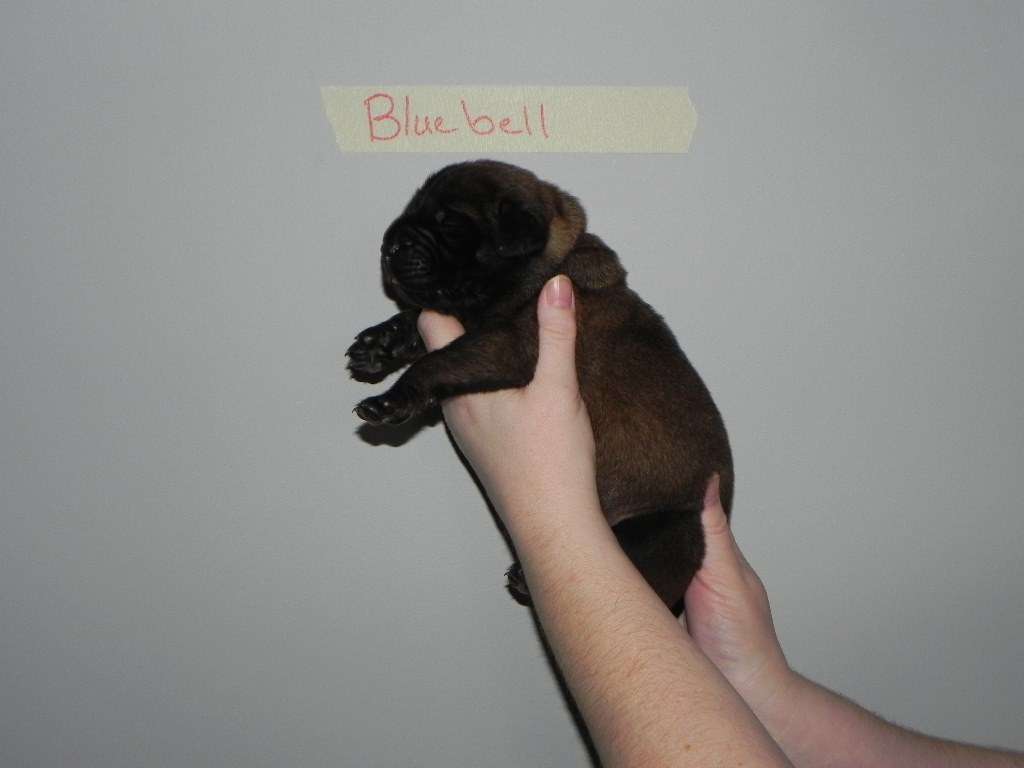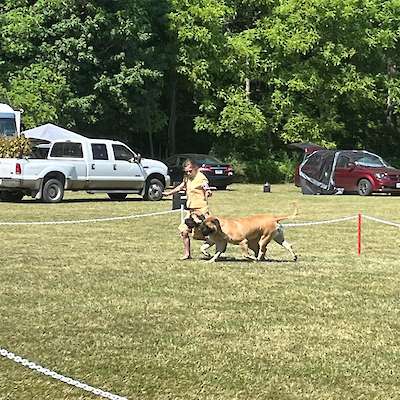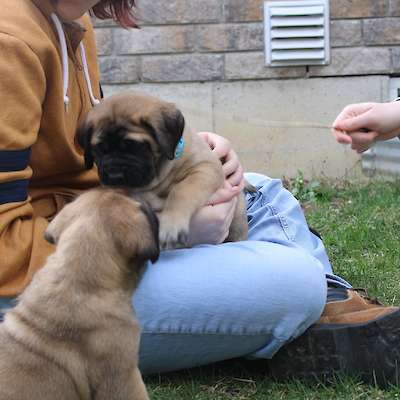Puppy Fetal Development

In this article, we explore the week by week development of a puppy fetus, along with some information on how pregnancy progresses for mom.
While most people don't think of puppy fetal development when they are getting a puppy, I find it interesting to understand the development of a puppy right from the very first day. This article goes through the fetal milestones, which we look at in terms of weeks.
When we look at puppy fetal development, we count days from first breeding and usually look at the magic number of 63, although this is not 100% accurate. As ovulation can occur before or after that first breeding, pregnancy can range from 59 to 70 days. So while the average pregnancy is 63 days from ovulation, it may only be 59 days from time of the first breeding and up to 70 days from that first breeding.
Week One: Day 1 to 7
With breeding dogs, the first week begins on the day of the first breeding, not at the end of the week after the first breeding. At this point, the bitch is not pregnant and she has simply been bred. Depending on timing, it can still be a few days before fertilization occurs between the sperm and the eggs so you aren't going to really see much difference in a bitch. She may be a bit tired after breeding but it really varies depending on the individual female. Some show no signs of being bred and are happy to go for a run seconds after breeding, which breeders try to discourage for obvious reasons.
Although she's been bred, a female is not out of heat for several more days. The average timeframe is between 4 to 14 days after the first breeding. During that time, she can be bred again by either the same male or a different one, which is why it is important to keep her away from other male dogs. Many breeders will do multiple breedings over the course of the heat, but count either from ovulation, determined with a blood test, or date of the first breeding for the due date.

Week Two: Day 8 to 14
At this point, breeding should be done and not much has changed with the dam. In fact, life should be as normal for her as possible. During this week, the eggs have been fertilized but they have not implanted yet. While you shouldn't exert the dog more than she normally would be, you can go back to normal levels of activity while she is still in heat. Remember that she should be kept away from other males to prevent an accidental breeding from happening. My rule of thumb is to always wait until 28 days from the start of the heat before you can let her mingle with other dogs, however, this can vary from dog to dog.
Overall, not much is happening for mom. At this stage, dogs don't show a lot of differences in regards to temperament and you may be experiencing some temperament changes due to her being in heat.
Inside, the eggs are fertilized and are becoming embryos. Splitting as they form a more complex cell that will become the puppy. During this week, the embryo will split from 2 cell, to 4 cells and then finally to a complex 64 cell embryo where it becomes a fetus with a head and spine.
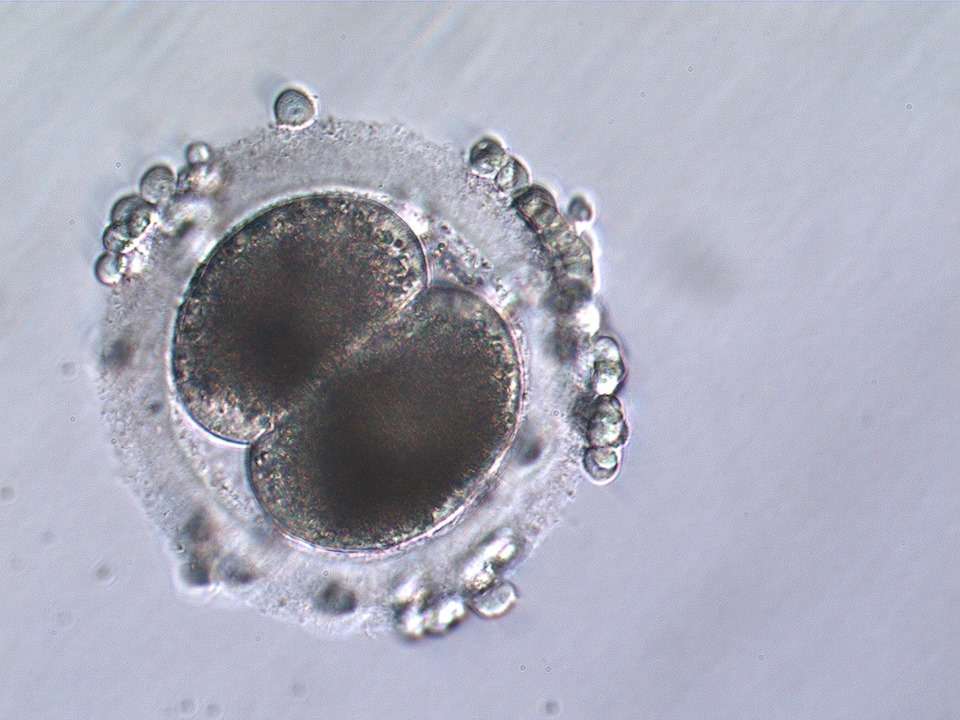
Week Three: Day 15 to Day 21
By the end of week three, some exciting things are happening. First, around day 17 to 22, the embryos will implant into the uterine walls. They start very high up in the uterine horns, which will fill up as they get older.
During this stage, not a ton is happening with mom. She may have some temperament changes, may have a change in appetite (ie, eating more or less). Or she may simply be her usual self.
An interesting fact, and the reason that a pregnancy test can't be done after breeding, is that a female dog will produce the same hormones whether she is pregnant or not and is the reason why dogs exhibit false pregnancies. As an aside, there is a blood test that can be performed between 22 and 28 days of pregnancy that looks for relaxin. This is a hormone that is produced due to the developing placentas. While some breeders have had a lot of success with relaxin, it is not 100% reliable at determining pregnancy with both false positives and negatives being reported.
While not a lot is happening on the outside, inside, things are happening! The cell division continues as it moves down into the uterus and implantation happens. Once implantation happens, the placenta starts to develop, providing nutrients to the embryo, and the early form of the fetus takes shape.
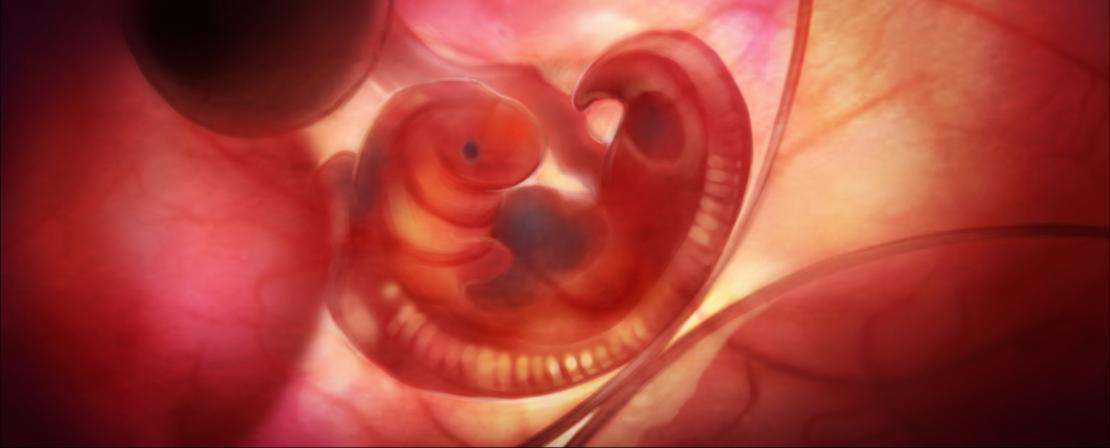
Week Four: Day 22 to 28
Once it has implanted, the puppy begins to develop. Development begins on week 4, which is day 22 to day 28. During this time, puppy is still very small, and will only reach 1/4 to a 1/2 inch (5 to 10mm) by day 28. However, it is starting to take shape.
Over this week, the spinal cord begins to develop. In addition, the head portion of the embryo should be bending forward and the brain and the shape of the face will begin. Eyes will start to develop. Finally, the puppy's limb buds should be developing.
For the mom, week 3, around implantation, and into week four, she may exhibit canine morning sickness, which is usually a loss of appetite, although some dogs will throw up. She may not show any outward signs at this point but a vet or experienced breeder may be able to palpitate for puppies, which feel like walnuts. (As a side, I do not palpitate as it can damage the puppies if you are not careful.)
The dam's nipples may begin to darken and enlarge but again, this can be seen with false pregnancy. It can also be common for a dam to not show any outward signs, even at the end of the fourth week.
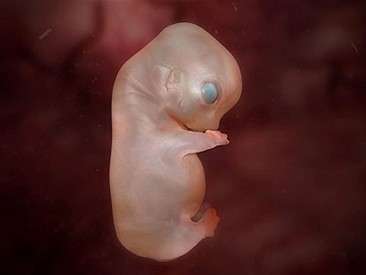
Week Five: Day 29 to 35
Week 5 is a busy time for puppy development. Over this week, the puppies will begin to look like puppies and by the end of the week, we will even have gender!
At this stage, the claws and individual digits are developed and can be seen. Originally, the puppy's eyes were open but by day 32, the eyelid has developed and the eyes will be closed. They will remain closed until roughly 2 weeks after delivery (give or take a few days). As I mentioned, they are decidedly more dog like in appearance. The weight of the puppy at this stage is roughly 2 grams and he should measure about 30 to 35mm in length (slightly over an inch).
Whisker buds will develop and on day 35, they will move from being called an embryo to being a fetus.
For mom, changes can really differ depending on the condition of the bitch before breeding, and the breed. English Mastiffs have a lot of room for puppy so it may be harder to notice much of a change in the dam at this stage. However, there should be some swelling in the belly and some weight gain.
Also, her needs are changing and the shift to puppy food is done gradually during this week. Some dogs see a return in appetite while others may not have much of an appetite all the way through their pregnancy.
One thing of note at this stage, an ultrasound can be done on day 30 to determine if your bitch is pregnant. Some vets will do the ultrasound sooner but my vet prefers day 30, from first breeding, on the dot. Other vets may wait until day 35. At any rate, if an ultrasound is being done, it will be during this week!
The photo below shows you a 35 day old puppy fetus.
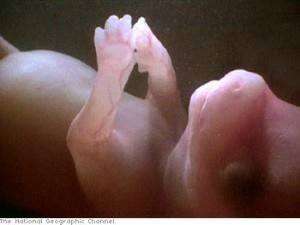
Week Six: Day 36 to 42
Week 6 is an exciting time!
As I mentioned, by day 35, the sex of the puppy is clearly determined. During this week, you will also be able to see the claws and individual digits. The fetus looks decidedly more dog like in appearance.
By the end of the week, the puppies should be about 44mm or nearly 2 inches! Weight should be at about 2 grams. Skin pigmentation is developing as well at this stage. Claws should be formed and the skeleton of the puppy should be solidifying. Most of what makes a puppy look like a puppy has developed at this stage and from this point on, most development will focus on growth.
For mom, she has reached the third and final phase of gestation. Her tummy should be getting larger and her pregnancy may be noticeable to others. It should be noted that this depends on the female and the breed. Some bitches, especially athletic, first time pregnant females, don't show until close to delivery. During this week, the bitch may experience a loss of appetite and will need a higher nutritional level. Meals are increased to two or three a day.
The photo below is of a puppy fetus at 40 days gestation.

Week Seven: Day 43 to 49
Week 7 doesn't really have a lot going on in regards to puppy fetal development. Most of the heavy development is done and now puppies will gain the most growth.
Around day 45, the hair will begin to grow on the puppy. In addition, the coloration of the hair can be seen and the pigment of the skin is established. Proportion wise, the puppy is slightly off but that will correct itself within the next week or so.
Mom is usually uncomfortable by this stage, however, it does depend on the individual dog and also on the individual litter. She may vomit occasionally and may not be interested in eating her meals. Smaller, more frequent meals will help with the pressure that is against her stomach. Generally, the dam is tired by this week and is often looking for a place to whelp.
By week seven, especially near the end of the week, puppy movement may be felt, but again, it depends on the dog and litter. The dam’s nipples may be well-developed at this point and there may be some “first milk” being produced.
Again, these symptoms are all generalizations. Some dam’s do not produce first milk until the puppies are born, some are not tired, some eat fine, and some are tired earlier in the pregnancy.
The photo is of a 7 week puppy fetus.
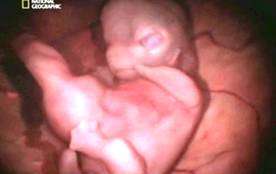
Week Eight: Day 50 to 58
During week 8, not a lot is happening but it is a very exciting time!
We are getting close to the whelping date; however, any puppy born in this week are not likely to survive. This is week 8 and much like last week, the puppy is not developing in more ways than just growth. The puppies should have fur completely and they may be moving a lot as they prepare for birth in the upcoming week. They are very crowded and the dam is usually very uncomfortable at this stage. One interesting fact is that by day 50, the puppies have fully ossified skeletons. Before this time, they were not visible in an x-ray, however, after day 50, they can be.
During this week, a lot of breeders opt for an x-ray to determine how many puppies are in the litter. The closer to the due date the x-ray is done, the easier it is to count puppies.
For the dam, she will be continuing to gain weight. She will also be looking for a place to whelp and will start whelping behaviors such as digging, finding a quiet place in the house (or on your lap) and preparing herself for the upcoming delivery.
The breeder should be very busy as well making sure that her whelping area is set up and she has all the supplies needed for the upcoming delivery. If puppies are being delivered by c-section, her vet should be on standby.
The photo is of a 8 week puppy fetus.
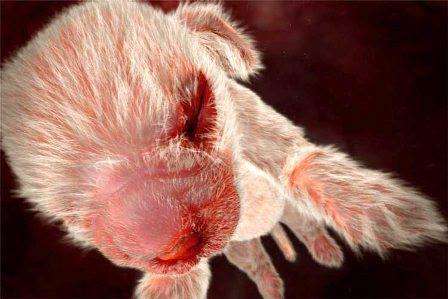
Week Nine: Day 59 to 65
This is it! Delivery week! During this week, puppies are gaining their last few ounces of weight and mom tends to be quite uncomfortable as you both wait for puppies to arrive.
Any day this week can be a safe delivery for puppies, although, most puppies are born around day 63. Larger litters tend to be born earlier, while smaller litters tend to be later.
Mom might not be interested in eating this week because of how uncomfortable she is but it is important to offer her smaller meals so she can eat when she wants to. If a dam hasn't delivered by day 65, I like to check with my vet. They may recommend a c-section or possibly have you wait a few more days. The time to really worry is day 70 if puppies have not arrived.
It is interesting to note that puppies are born without sight or hearing. This development continues as they grow outside of the womb. For more information on eye development, please read our article on it.
